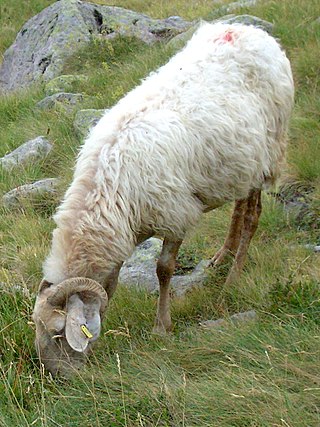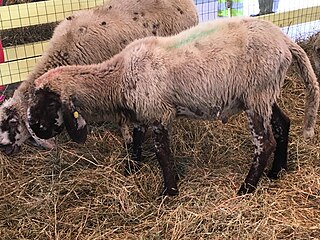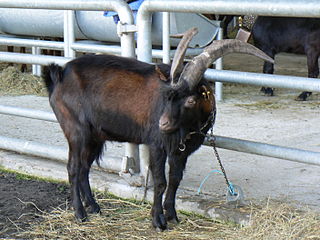Related Research Articles
The Jonica is a breed of domestic goat from the province of Taranto, in Puglia in southern Italy. The origins of the breed are uncertain; it is thought to have originated from crossing of local varieties with the Maltese breed. The Jonica is one of the eight autochthonous Italian goat breeds for which a genealogical herdbook is kept by the Associazione Nazionale della Pastorizia, the Italian national association of sheep-breeders.
The Fabrianese is a modern breed of domestic sheep from the Marche region of central Italy. It takes its name from the town and comune of Fabriano, in the province of Ancona. The Fabrianese was created as a dual-purpose breed in the 1960s by cross-breeding local breeds of the Apennines of the Marche with rams of the Bergamasca breed from the Alps of Lombardy. It is raised in the eastern foothills of the Apennines, in the provinces of Ancona, Ascoli Piceno and Macerata in the Marche, and in the province of Terni in Umbria.
The Bagnolese is a breed of sheep from the area surrounding Bagnoli Irpino in the province of Avellino, in Campania in southern Italy. It takes its name from that of the town. It is raised principally in Irpinia, in the Monti Picentini, in the Monti Alburni, in the Piana del Sele and in the Vallo di Diano. It probably derives from the Barbaresca breed, and may also have been influenced by the Comisana. It is one of the forty-two autochthonous local sheep breeds of limited distribution for which a herdbook is kept by the Associazione Nazionale della Pastorizia, the Italian national association of sheep-breeders.

The Brigasca, French: Brigasque, is a breed of sheep from Liguria in north-west Italy and the département of Alpes-Maritimes in south-eastern France. It takes its name from the town of La Brigue, which was until 1947 in the Italian province of Cuneo. The Brigasca is raised in the provinces of Imperia and Savona in Italy, and neighbouring areas in France. It appears to have origins in common with the Frabosana and Delle Langhe breeds. It is one of the forty-two autochthonous local sheep breeds of limited distribution for which a herdbook is kept by the Associazione Nazionale della Pastorizia, the Italian national association of sheep-breeders.
The Ciavenasca is a breed of small domestic sheep from the province of Sondrio, in Lombardy in northern Italy. It is raised in the mountainous terrain of the Val San Giacomo, the Val Bregaglia and the Valchiavenna, from which the name of the breed derives. It is raised only for meat; the wool is of very poor quality, and the milk is sufficient only for the lambs. It is one of the forty-two autochthonous local sheep breeds of limited distribution for which a herdbook is kept by the Associazione Nazionale della Pastorizia, the Italian national association of sheep-breeders.
The Cornella Bianca is a breed of domestic sheep from the Apennines of Emilia–Romagna in central Italy. It is raised principally in mountainous parts of the provinces of Bologna, Modena and Reggio Emilia, where it is transhumant. Some are also raised in the plains around Ferrara, Rovigo and Vicenza. It is found particularly in the comuni of Minerbio, Baricella and Malalbergo in the province of Bologna and Argenta in the province of Ferrara.

The Cornigliese or Corniglio is an Italian breed of domestic sheep from the Apennines of the province of Parma, in Emilia–Romagna in central Italy. It takes its name from the mountain town of Corniglio in that province; it may also be called Borgotarese after the town of Borgo Val di Taro which is about 40 km to the west. It is raised in the provinces of Bologna, Ferrara, Modena, Parma, Ravenna and Reggio Emilia.
The Finarda is a breed of large domestic sheep from the regions of Lombardy and Piemonte in northern Italy. It is heavy breed raised mainly for meat, although it also yields 4–6 kg of wool per year. It results from cross-breeding the Bergamasca and Biellese breeds. It is one of the forty-two autochthonous local sheep breeds of limited distribution for which a herdbook is kept by the Associazione Nazionale della Pastorizia, the Italian national association of sheep-breeders. However, in 2008 the herdbook was empty, and may in fact never have been activated. Most data for the breed dates from 1983.
The Frabosana is a breed of sheep from the valleys of the Monregalese, the area around Mondovì in the province of Cuneo, in Piemonte in north-west Italy. It takes its name from the comuni of Frabosa Soprana and Frabosa Sottana, and was once the most numerous sheep breed of Piemonte. It is raised in the Valle Gesso, the Valle Grana, the Valle Pesio, the Valle Vermenagna and the Valli Monregalesi, and in the Val Pellice. Two types are recognised within the breed, the Roaschino in the Ligurian Alps, and the slightly smaller Frabosana raised in the area of Mondovì. The Frabosana is one of the forty-two autochthonous local sheep breeds of limited distribution for which a herdbook is kept by the Associazione Nazionale della Pastorizia, the Italian national association of sheep-breeders.
The Garessina or Muma is a breed of small sheep from the Garessina, the area surrounding Garessio in the province of Cuneo, in Piemonte in north-west Italy. It is raised principally in the valleys of the Tanaro, its affluent the Negrone, and the Casotto; it is not raised commercially, but kept as a family sheep. It has been influenced by Spanish Merino and French Alpine breeds. The wool is of fine quality. The Garessina is one of the forty-two autochthonous local sheep breeds of limited distribution for which a herdbook is kept by the Associazione Nazionale della Pastorizia, the Italian national association of sheep-breeders.
The Garfagnina Bianca is a breed of small domestic sheep from the historic area of the Garfagnana, the mountainous northern part of the province of Lucca, in Tuscany in central Italy. It shares common origins with the Cornella Bianca, Massese and Zerasca. It is one of the forty-two autochthonous local sheep breeds of limited distribution for which a herdbook is kept by the Associazione Nazionale della Pastorizia, the Italian national association of sheep-breeders.

The Rosset is a breed of domestic sheep from the Valle d'Aosta in north-west Italy. It is morphologically similar to the Savoiarda breed from Piemonte and to the Thônes et Marthod breed from Savoie; it may have been influenced also by the Blanc des Alpes and the Biellese. It is one of the forty-two autochthonous local sheep breeds of limited distribution for which a herdbook is kept by the Associazione Nazionale della Pastorizia, the Italian national association of sheep-breeders.
The Sambucana or Demontina is a breed of upland sheep from the province of Cuneo, in Piemonte, north-west Italy. It takes its name from the comune of Sambuco in the Valle Stura di Demonte, the area where it is thought to have originated; the other name of the breed, Demontina, derives from the name of that valley. The Sambucana is also raised in the adjoining valleys, the Valle Gesso, the Valle Grana and the Valle Maira. It is one of the forty-two autochthonous local sheep breeds of limited distribution for which a herdbook is kept by the Associazione Nazionale della Pastorizia, the Italian national association of sheep-breeders.
The Trimeticcia di Segezia is a modern breed of domestic sheep from Puglia in southern Italy. It is named for the town of Segezia, a frazione of Foggia, where it was created at the Istituto Sperimentale per la Zootecnia, an experimental breeding station of the Ministero delle Politiche Agricole, Alimentari e Forestali, the Italian ministry of agriculture. "Trimeticcia" means "three-way hybrid": the breed was created by cross-breeding Gentile di Puglia ewes with French Île-de-France rams, and then crossing the resultant hybrid with Württemberger rams; the resulting stock was selectively bred for adaptation to the climate and conditions of the area. The range of the breed is principally the plain of the Tavoliere delle Puglie, but extends also into Molise. The Trimeticcia di Segezia is one of the forty-two autochthonous local sheep breeds of limited distribution for which a herd-book is kept by the Associazione Nazionale della Pastorizia, the Italian national association of sheep-breeders.
The Tacola is a breed of domestic sheep from the mountains of Piemonte in north-west Italy. It is raised in the provinces of Biella, Cuneo and Turin, particularly in the area of Biella and the Valsesia. It apparently derives from the Biellese, from which it is distinguished by its short ears. It is one of the forty-two autochthonous local sheep breeds of limited distribution for which a herdbook is kept by the Associazione Nazionale della Pastorizia, the Italian national association of sheep-breeders.
The Barbaresca or Barbaresca Siciliana is a breed of large fat-tailed sheep from the Mediterranean island of Sicily, in southern Italy. It derives from the cross-breeding between indigenous Sicilian Pinzirita sheep with fat-tailed Barbary sheep of Maghrebi origin. These were probably brought to the island after the Muslim conquest of Sicily in the 9th century; Arabic texts preserved at Agrigento document the movement of large numbers of sheep to the Sicilian interior.
The Delle Langhe, also called Pecora delle Langhe or Langarola, is a breed of domestic sheep indigenous to Piedmont, in north-western Italy. It is a rough-woolled breed of southern Mediterranean type, and originates from the mountainous area of the Alta Langa, where the Apennines meet the Alps, in the province of Cuneo. It is raised mainly in the Langhe, but is found in several other regions of Italy including Abruzzo, Basilicata, Emilia–Romagna, Liguria and Tuscany.
The Sempione is a rare breed of domestic goat from the mountains of Piemonte in north-western Italy and the neighbouring area of Simplon in the canton of Valais in Switzerland; Sempione is the Italian name for Simplon. The Sempione goat is well documented in photographs from the early twentieth century, but is now thought to be close to extinction, and has more than once been considered extinct. Examples were recorded at Saliceto di Cravagliana in the province of Vercelli in 1983, and others have since been identified in the province of Verbano-Cusio-Ossola, particularly in the Val Divedro and the upper Ossola.
The Roccaverano is an indigenous breed of large domestic goat from the Langhe, in the provinces of Asti and Cuneo, in Piemonte in north-western Italy. It is raised mainly in the Langa Astigiana, mostly within the Comunità montana Langa Astigiana Val Bormida, and is named for the town and comune of Roccaverano in that area. The origins of the breed are unknown.

The Alpina Comune is a heterogeneous population of domestic goats widely distributed in the Alps of northern Italy, particularly in the regions of Lombardy and Piemonte. It is highly variable in size, in morphological characteristics such as the type, colour and pattern of its coat and the shape and carriage of its ears, and in type of use. It does not display any of the uniformity characteristic of a breed, other than a consistent hardiness and adaptation to mountain terrain. It is however officially recognised and protected as one. The name Alpina Comune, "common", is more used in Piemonte; in Lombardy it may be called Alpina Locale, "local", or simply Nostrana, "ours".
References
- ↑ Barbara Rischkowsky, D. Pilling (eds.) (2007). List of breeds documented in the Global Databank for Animal Genetic Resources, annex to The State of the World's Animal Genetic Resources for Food and Agriculture. Rome: Food and Agriculture Organization of the United Nations. ISBN 9789251057629. Archived 23 June 2020.
- 1 2 3 Daniele Bigi, Alessio Zanon (2008). Atlante delle razze autoctone: Bovini, equini, ovicaprini, suini allevati in Italia (in Italian). Milan: Edagricole. ISBN 9788850652594. p. 268–269.
- 1 2 Breed data sheet: Saltasassi/Italy. Domestic Animal Diversity Information System of the Food and Agriculture Organization of the United Nations. Accessed September 2013.
- ↑ Le razze ovine e caprine in Italia (in Italian). Associazione Nazionale della Pastorizia: Ufficio centrale libri genealogici e registri anagrafici razze ovine e caprine. p. 72. Accessed September 2013.
- ↑ Consistenze Provinciali della Razza G0 SALTASASSI Anno 2012 (in Italian). Associazione Nazionale della Pastorizia: Banca dati. Accessed September 2013.